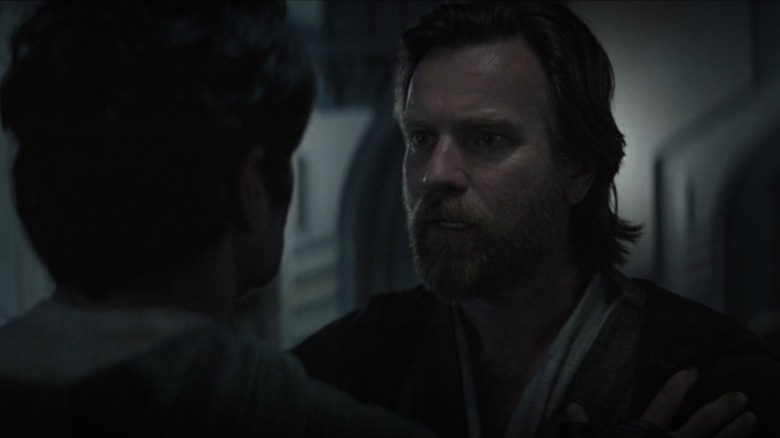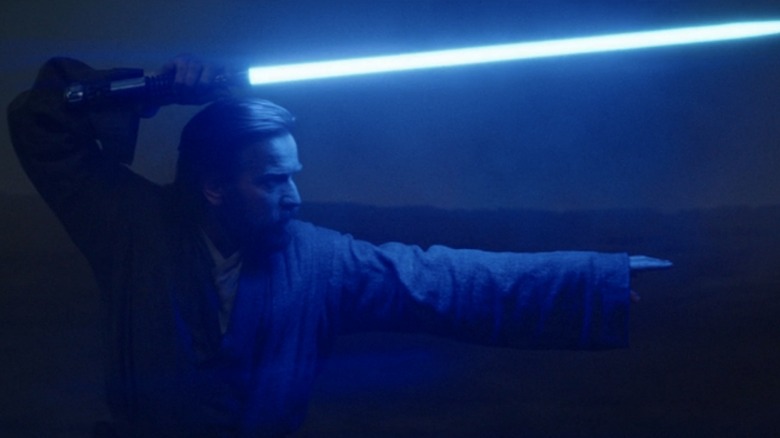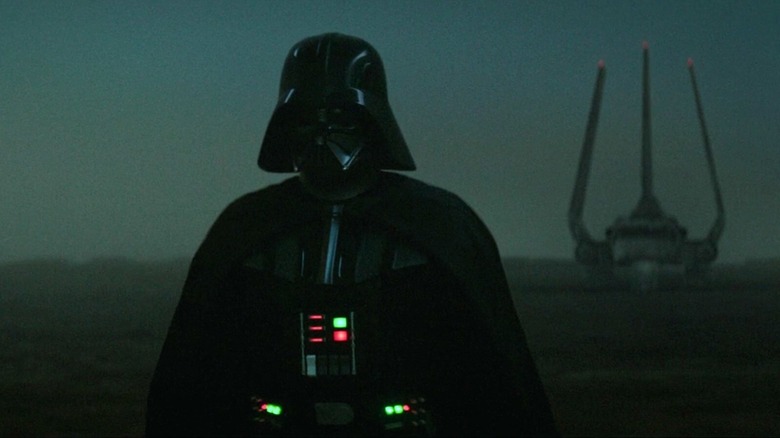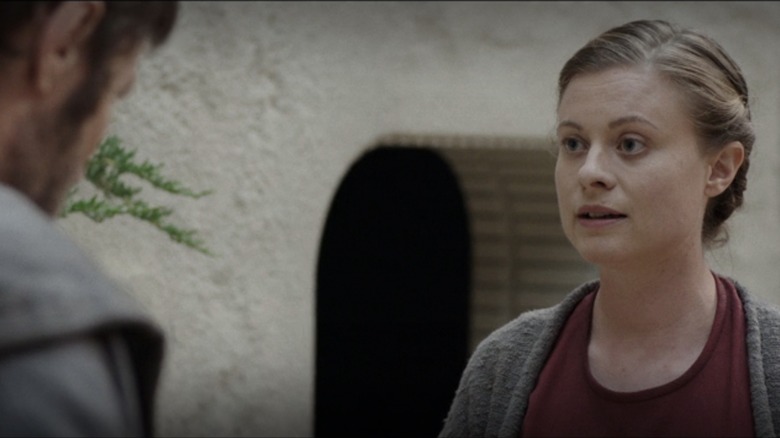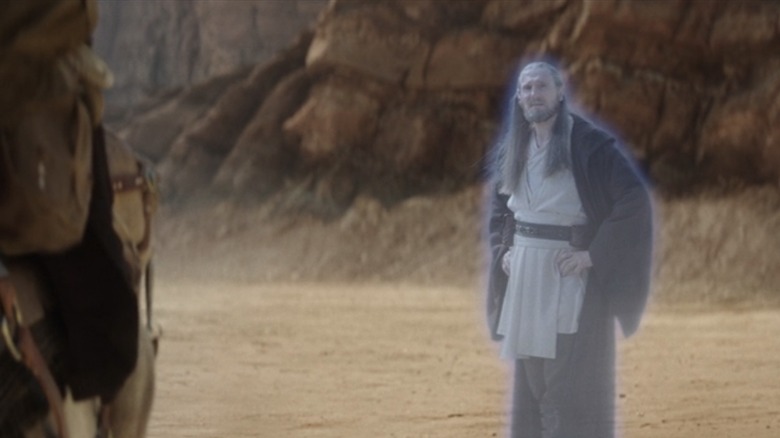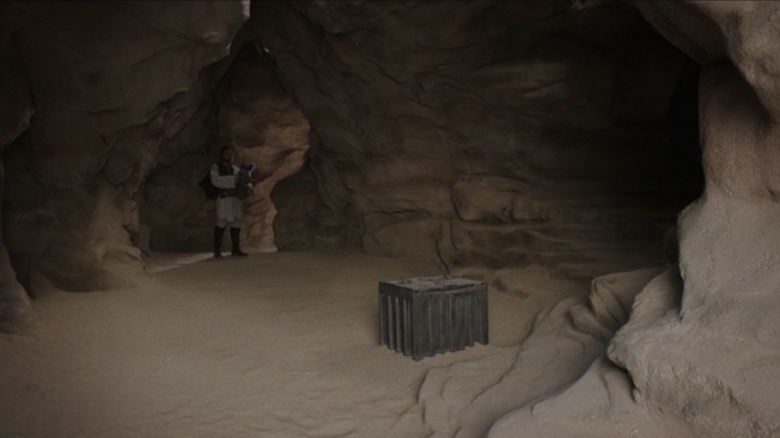Obi-Wan Kenobi Episode 6 Gives Us A Stunning Finale That Brings A Return Of The Jedi
Spoilers follow.
The final installment of Obi-Wan Kenobi's six-episode series picks up where the last left off, with Obi-Wan Kenobi and Leia running from Darth Vader's Devastator in a broken ship. In order to secure the escape of the refugees, Obi-Wan flees to a nameless nearby planet in a dropship, leading Vader to him.
Meanwhile, on Tatooine, Reva hunts for young Luke Skywalker, in a bid to get vengeance for her friends and take something from Darth Vader, though he doesn't even know his children exist. As Owen and Beru battle against the severely wounded Reva to defend Luke, Obi-Wan faces off against his former apprentice.
Vader and Obi-Wan battle across the rocky landscape of the distant planet to a standstill. Vader leaves Obi-Wan for dead, but the Jedi finds a burst of peace and hope in the future and returns to face his apprentice again with new strength. With the odds evened, Obi-Wan disables Vader's suit and hacks his mask so that master and student can see each other again. Though it might not have been his intention, Vader absolves Obi-Wan of the murder of Anakin Skywalker, taking responsibility for his own actions.
Obi-Wan leaves Vader for dead once more on the planet and senses a disturbance in the Force that leads him straight back to Tatooine in an attempt to rescue Luke from Reva's vengeance. On one hand, Obi-Wan is too late and Reva walks back into the desert with Luke in her arms. On the other hand, she cannot kill the boy and turn herself into a monster like Vader.
Vader, on the other hand, makes it back to his fortress on Mustafar and wants to hunt for Kenobi further, but is told by his master to ignore Kenobi, there are more important things in the galaxy for them to deal with. If Vader can't focus, then perhaps he is not fit to be the apprentice of Darth Sidious.
With Luke safe on Tatooine, Leia returned home to Alderaan, Reva on the run and discovering her next life, Obi-Wan has a new purpose and companionship in the newly appeared ghost of his old master, Qui-Gon Jinn.
Return of the Jedi and more
It's been noted that each of the six episodes of "Obi-Wan Kenobi" have featured prominent themes from each of the corresponding "Star Wars" films in Anakin Skywalker's story. At that point, this episode would correspond to "Return of the Jedi," and it does bear some markers to that movie. Reva actually fills the Luke Skywalker role, refusing to give in to the anger in her heart and casting aside her lightsaber. Vader is once again unmasked, forced to reckon with the actions of his past, though this time he is completely unrepentant. And Obi-Wan finds new peace, just as Luke did, ending the entire saga with the Force ghost of his former master. But, like any good "Star Wars" installment, it references far more than that. This episode had a number of ties to all of the prequels, as well as "Star Wars Rebels."
Going through them one by one, the moments that caught me from "The Phantom Menace" were the contrast in Luke's upbringing to Anakin's as he races into a junk shop for parts. The boy has already broken something on a speeder and one wonders if he's already driving speeders himself, despite his young age, bringing to mind his father racing pods as a child. The second, more touching callback moment from "The Phantom Menace" comes at the end of the episode, when Obi-Wan tells Leia of her parents, and she asks tearfully, "Will I ever see you again?"
These are the exact words her father had the last time he saw his mother before her death, one of the most emotional scenes in "The Phantom Menace."
In "Attack of the Clones," Anakin Skywalker — a Jedi — does a very Sith-like thing and murders the sand people, carrying the body of his mother home to the Lars homestead. In this episode, Reva — a user of the Dark side — does a very Jedi-like thing and delivers Luke alive after being merciful, in very much the same way. She even echoes some of his lines, "He killed them all ..." But she is able to turn from this darkness and learn from Anakin's failures.
Referencing "Revenge of the Sith," Obi-Wan and Anakin echo some of their lines from their duel, with Obi-Wan even repeating verbatim, "I will do what I must." The episode also offers moments of Vader that echo the "Frankenstein" elements that George Lucas put in the foreground of Anakin's character in the final film of the prequels, particularly in his final moments with Obi-Wan, where Obi-Wan learns more of the monster's motives. But this moment of Obi-Wan leaving Vader alive evokes the wisdom of Gandalf, a character that Obi-Wan very much resembles as he gets older. Pity stayed his hand, and for all of the destruction and evil Vader wrought over the next decade, it was this pity that enabled Luke to bring Anakin back to the light and destroy the Sith.
Twilight of the Apprentice
Perhaps the most fascinating parallel to the rest of "Star Wars" in this episode comes in the form of the "Star Wars Rebels" episode "Twilight of the Apprentice." In that second season finale episode of "Rebels," Vader faces off against his former padawan, Ahsoka Tano, and she is able to similarly crack open his helmet and reveal the Anakin beneath. In this confrontation with Ahsoka, Vader reaffirms that he killed Anakin Skywalker and Ahsoka even believes they aren't the same person — but her hopes are dashed when she learns the unvarnished truth.
This cycle of masters and apprentices looking to teach and destroy and save each other is seen throughout this entire line of Jedi and creates really fascinating symmetries in the storytelling.
The episode of "Rebels" (and really the entire series) informs more of the story of Vader and the depths he's willing to sink to in his pain and anger. Another episode, "Twin Suns," offers us our next chronological window into Obi-Wan Kenobi and shows how much his character trajectory changed and was uplifted by the events of this series. "Rebels" would be an excellent follow-up to "Obi-Wan Kenobi" for anyone looking for more emotional "Star Wars" storytelling.
Aunt Beru, Badass
As Uncle Owen learns of Reva's arrival on Tatooine, he comes to his wife, Beru, and tells her that they need to flee to protect Luke. Beru has another plan. She produces firearms she's secreted away and says they will defend themselves as though she's been a fighter all her life. If one read E.K. Johnston's trilogy of Padmé books, that guess about Beru would not be far off. We learned in the books that Beru had been working to free slaves across Tatooine, continuing the work of Sabé, Padmé's handmaiden who had been sent to complete the task. She worked as part of an underground organization that got the explosive devices installed in enslaved people disabled and then helped whisked these newly free folk to nearby planets for new lives.
This episode showcases her capability and gives Luke another female role model to look up to.
Details to watch out for
Some amazing cameos in this episode really tie "Obi-Wan Kenobi" to the rest of the "Star Wars" mythos. Naturally, Bonnie Piesse and Joel Edgerton reprise their roles as Uncle Owen and Aunt Beru. Jimmy Smits returns as Bail Organa, but they've all been on the show before. This episode brings us Ian McDiarmid as the Emperor once more, as well as the return of Liam Neeson as Qui-Gon Jinn in the form of a Force ghost.
It feels like there are other film references in this episode as well, but the most notable feels like a nod to John Ford's "The Searchers." When Obi-Wan is boarding his ship on Alderaan, he looks out on the Organa family from the door, just as John Wayne's Ethan does at the end of the classic western film. In both cases, these dinosaurs from another time wistfully look out at the lives they can't have, knowing their fates are inexplicably tied to the past.
This episode also brings out the most classic of "Star Wars" musical cues. Princess Leia's theme, the Imperial March, the Force theme, even hints of Battle of the Heroes and Anakin's theme all blend in together by Natalie Holt in a masterful way. There will be a lot of dissection of the musical choices from this show because they're so right and tie back to the originals in such great ways.
Remember your failure in the cave
Caves have long held a special significance in mythology and philosophy. The cave was where Luke went to grapple with the dark side in "The Empire Strikes Back" and returned with new knowledge of himself, despite his failure. In Plato's allegory of the cave, those imprisoned within it do not want to see the truth of the world, preferring the shadows of the world left by the flames of the fire. It is only with that learning and understanding that one can be free of the cave. It's no wonder that Obi-Wan begins this series living in a cave. Only after his trial by fire (in some cases literally) does he find a renewed hope in his mission that puts him on a better, more clear-eyed path, and is he able to escape the cave.
Qui-Gon practically references it at the end of the show, and this shows the ultimate dichotomy between the dark side and the light. Qui-Gon works to free Obi-Wan from the cave and show him a larger world of hope. Sheev Palpatine works in the shadows, keeping Vader trapped inside the cave and away from that enlightenment, focusing him on anything else.
The final episode of "Obi-Wan Kenobi" sums both of these up completely and offers us a satisfying look at the journeys that master and apprentice take in their opposite poles of fate. "Look what I have risen above," Obi-Wan tells Maul on Tatooine a few years later in "Twin Suns," a seminal episode of "Star Wars Rebels." And it is only through this story do we truly get to see how he does it.
Deborah Chow, Ewan McGregor, and the rest of the team that brought us this story deserve to take a bow for bringing us something emotional and urgent with a story many people thought didn't need to be told. But tell it they did, and reminded us once more, over and over and over again, that we win not by fighting what we hate, but by saving what we love.
And what can be more "Star Wars" than that?
